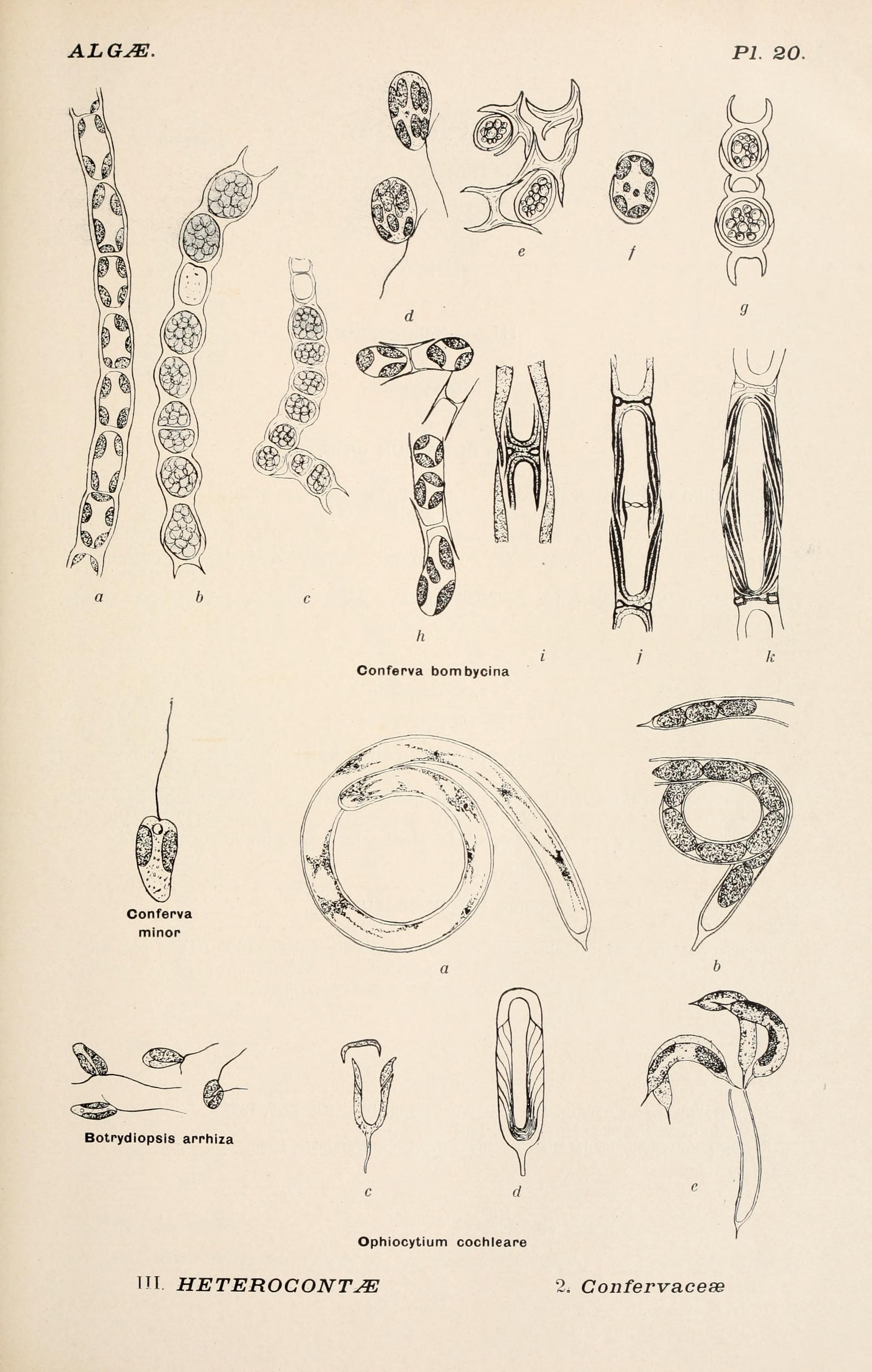Explore: Euglenineae
Discover books, insights, and more — all in one place.
Learn more about Euglenineae with top reads curated from trusted sources — all in one place.
AI-Generated Overview About “euglenineae”:
Books Results
Source: The Open Library
The Open Library Search Results
Search results from The Open Library
1Euglenoid flagellates
By Gordon F. Leedale

“Euglenoid flagellates” Metadata:
- Title: Euglenoid flagellates
- Author: Gordon F. Leedale
- Language: English
- Number of Pages: Median: 242
- Publisher: Prentice-Hall
- Publish Date: 1967
- Publish Location: Englewood Cliffs, N.J
- Dewey Decimal Classification: 589.44
- Library of Congress Classification: QL-0368.00000000.F5 L36
“Euglenoid flagellates” Subjects and Themes:
- Subjects: Euglenineae - Euglenoids - Flagellata - Flagella
Edition Identifiers:
- The Open Library ID: OL5541650M
- Online Computer Library Center (OCLC) ID: 554515
- Library of Congress Control Number (LCCN): 67019494
Book Classifications
- Dewey Decimal (DDC): ➤ ❛589.44❜.
- Library of Congress Classification (LCC): ➤ ❛QL-0368.00000000.F5 L36❜.
Access and General Info:
- First Year Published: 1967
- Is Full Text Available: Yes
- Is The Book Public: No
- Access Status: Borrowable
Online Access
Downloads Are Not Available:
The book is not public therefore the download links will not allow the download of the entire book, however, borrowing the book online is available.
Online Borrowing:
- Borrowing from Open Library: Borrowing link
- Borrowing from Archive.org: Borrowing link
Online Marketplaces
Find Euglenoid flagellates at online marketplaces:
- Amazon: Audiable, Kindle and printed editions.
- Ebay: New & used books.
2Euglenoidina parasitic in Copepoda
By Włodzimierz Michajłow
“Euglenoidina parasitic in Copepoda” Metadata:
- Title: ➤ Euglenoidina parasitic in Copepoda
- Author: Włodzimierz Michajłow
- Language: English
- Number of Pages: Median: 224
- Publisher: ➤ PWN-Polish Scientific Publishers
- Publish Date: 1972
- Publish Location: Warszawa
- Dewey Decimal Classification: 593.18
- Library of Congress Classification: QL-0368.00000000.E9 M5213
“Euglenoidina parasitic in Copepoda” Subjects and Themes:
- Subjects: Copepoda - Euglenoids - Parasites - Euglenineae
Edition Identifiers:
- The Open Library ID: OL5089360M
- Online Computer Library Center (OCLC) ID: 875243
- Library of Congress Control Number (LCCN): 74160781
Book Classifications
- Dewey Decimal (DDC): ➤ ❛593.18❜.
- Library of Congress Classification (LCC): ➤ ❛QL-0368.00000000.E9 M5213❜.
Access and General Info:
- First Year Published: 1972
- Is Full Text Available: No
- Is The Book Public: No
- Access Status: No_ebook
Online Marketplaces
Find Euglenoidina parasitic in Copepoda at online marketplaces:
- Amazon: Audiable, Kindle and printed editions.
- Ebay: New & used books.
3Naupliicola fennicus sp. n. (Embryocolidae), Dinema penetrans sp. n. (Peranemidae) and certain other Euglenoidina-Copepoda parasites from the countryside round Helsinki, Finland
By Włodzimierz Michajłow
“Naupliicola fennicus sp. n. (Embryocolidae), Dinema penetrans sp. n. (Peranemidae) and certain other Euglenoidina-Copepoda parasites from the countryside round Helsinki, Finland” Metadata:
- Title: ➤ Naupliicola fennicus sp. n. (Embryocolidae), Dinema penetrans sp. n. (Peranemidae) and certain other Euglenoidina-Copepoda parasites from the countryside round Helsinki, Finland
- Author: Włodzimierz Michajłow
- Language: English
- Number of Pages: Median: 15
- Publish Date: 1966
- Publish Location: [Helsinki
- Dewey Decimal Classification:
- Library of Congress Classification: Q--0060.00000000.F553 vol. 29, nr. 7
“Naupliicola fennicus sp. n. (Embryocolidae), Dinema penetrans sp. n. (Peranemidae) and certain other Euglenoidina-Copepoda parasites from the countryside round Helsinki, Finland” Subjects and Themes:
- Subjects: Copepoda - Euglenineae - Parasites
Edition Identifiers:
Book Classifications
- Library of Congress Classification (LCC): ➤ ❛Q--0060.00000000.F553 vol. 29, nr. 7❜.
Access and General Info:
- First Year Published: 1966
- Is Full Text Available: No
- Is The Book Public: No
- Access Status: No_ebook
Online Marketplaces
Find Naupliicola fennicus sp. n. (Embryocolidae), Dinema penetrans sp. n. (Peranemidae) and certain other Euglenoidina-Copepoda parasites from the countryside round Helsinki, Finland at online marketplaces:
- Amazon: Audiable, Kindle and printed editions.
- Ebay: New & used books.
Wiki
Source: Wikipedia
Wikipedia Results
Search Results from Wikipedia
Flagellate

Chrysophyceae, Bacillariophyceae, Cryptophyceae, Dinophyceae, Chloromonadineae, Euglenineae, Colourless Flagellata. 1935. Cambridge, England: Cambridge University
A flagellate is a cell or organism with one or more whip-like appendages called flagella. The word flagellate also describes a particular construction (or level of organization) characteristic of many prokaryotes and eukaryotes and their means of motion. The term presently does not imply any specific relationship or classification of the organisms that possess flagella. However, several derivations of the term "flagellate" (such as "dinoflagellate" and "choanoflagellate") are more formally characterized.
Euglena

S2CID 26079642. Pringsheim, E. G. (1948). "Taxonomic Problems in the Euglenineae". Biological Reviews. 23 (1): 46–61. doi:10.1111/j.1469-185X.1948.tb00456
Euglena is a genus of single-celled, flagellate eukaryotes. It is the best-known and most widely studied member of the class Euglenoidea, a diverse group containing some 54 genera and at least 200 species. Species of Euglena are found in fresh water and salt water. They are often abundant in quiet inland waters where they may bloom in numbers sufficient to color the surface of ponds and ditches green (E. viridis) or red (E. sanguinea). The species Euglena gracilis has been used extensively in the laboratory as a model organism. Most species of Euglena have photosynthesizing chloroplasts within the body of the cell, which enable them to feed by autotrophy, like plants. However, they can also take nourishment heterotrophically, like animals. Since Euglena have features of both animals and plants, early taxonomists, working within the Linnaean two-kingdom system of biological classification, found them difficult to classify. It was the question of where to put such "unclassifiable" creatures that prompted Ernst Haeckel to add a third living kingdom (a fourth kingdom in toto) to the Animale, Vegetabile (and Lapideum meaning Mineral) of Linnaeus: the Kingdom Protista.
Yellow-green algae

Chrysophyceae, Bacillariophyceae, Cryptophyceae, Dinophyceae, Chloromonadineae, Euglenineae, Colourless Flagellata. Cambridge University Press, Cambridge.[page needed]
Peranema

(September 1950). "Investigations of the Biology of Peranema trichophorum (Euglenineae)". Quarterly Journal of Microscopical Science. 3. 91 (91): 302. PMID 24539001